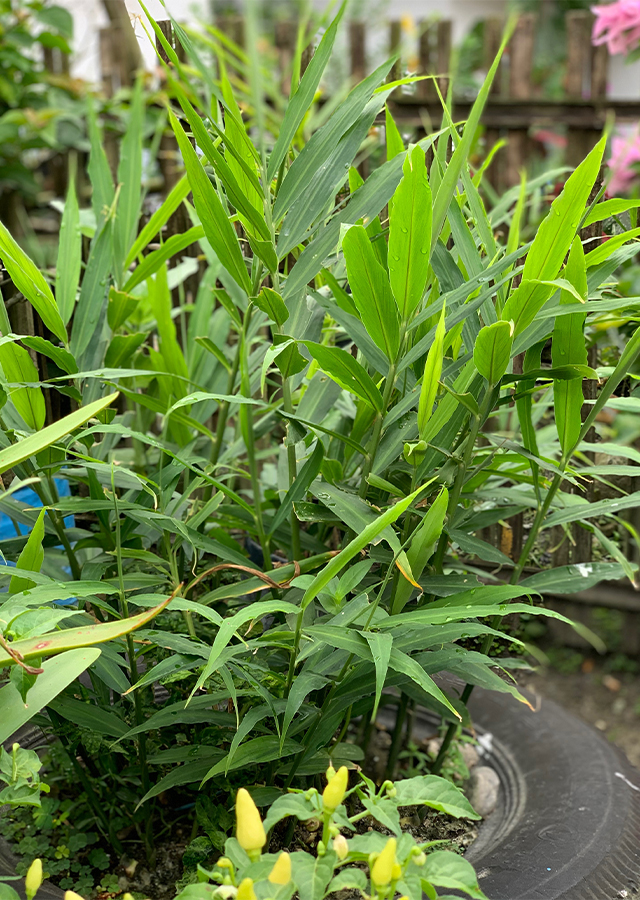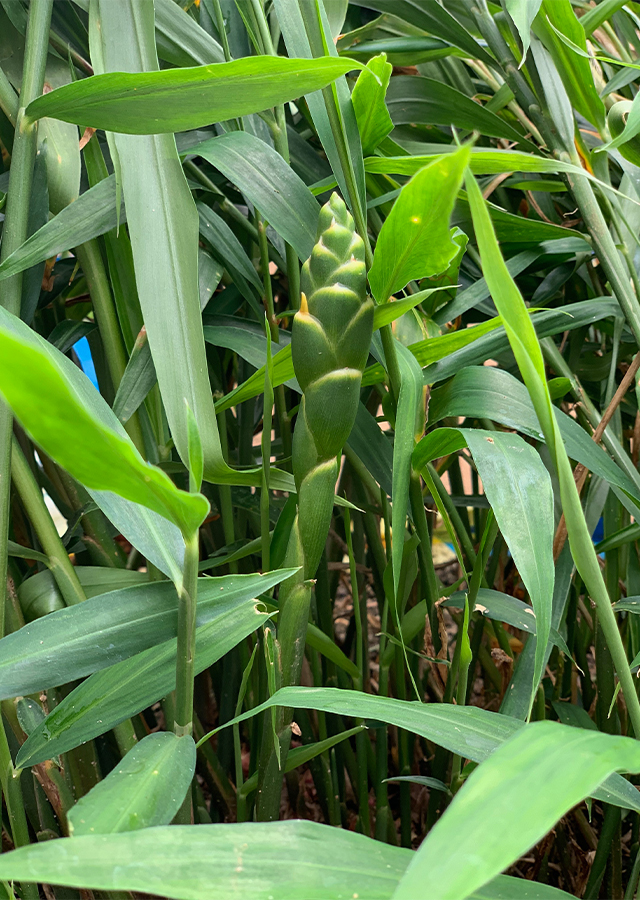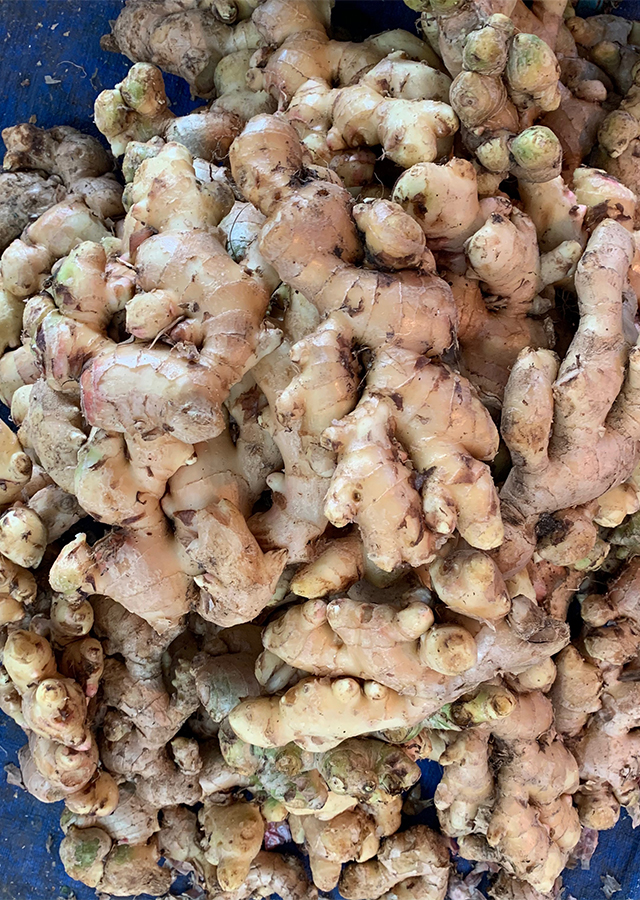Ginger
Zingiber officinale Roscoe
Zingiberaceae
Location in our garden
Principal



Synonym
Amomum angustifolium Salisb.
Amomum zingiber L.
Amomum zinziba Hill
Habitus
Herbaceous. A slender, erect, herbaceous perennial plant, growing from 30-150 cm tall
Part Used
Leaves
Rhizome
Growing Requirements
Full Sunshine
Need Shade
High Rainfall
Habitat
Forest
Overview
In Malaysia, various ginger types have been identified, such as 'haliyabetai,' the real ginger with pale-colored rhizomes, and 'haliya bara,' and 'haliya indang' with very pungent reddish rhizomes used primarily in medicine. Since many cultivars rarely flower or are sterile, it spreads mostly vegetatively.
Vernacular Names
Lao jiang (Chinese), Gingembre (French), Ingwer (German), Aale (India), Jinjaa (Japanese), Haliya (Malaysia), Gyin (Burmese), Luya (Philippines), Gengibre (Portuguese), Khing (Thai), Cay gung (Vietnamese).
Agroecology
In a deep but well drained loam of soil that is high in organic matter, Ginger grows best in warm and sunny climates. For growth, the optimum soil pH is between 6.0 and 6.5 and the plant needs a minimum temperature of 15.5 °C. For optimal growth and development, it needs an average annual precipitation of between 250 and 300 cm, and requires additional irrigation where precipitation is not adequate. It will not accept soil that is waterlogged.
Morphology
- Rhizome - robust fleshy, up to 2 cm thick, growing horizontally underground, but at a shallow depth, irregularly branched, but typically only in the vertical plane, covered with small, deciduous scales, leaving ring-like scars, pale yellow to reddish, irregularly wrinkled in the dried rhizome, pale yellow flesh, fragrant.
- Stems - pale green, sometimes reddish at the base, scales covering the lower part oblong, around 6 cm x 1 cm, scarcely white-pilose outside, upright, unbranched, mostly formed by the leaf sheaths.
- Leaves - pilose, especially in the upper portion, with white, glabrous margins, blade linear to lanceolate, up to 30 cm x 2 cm, light to dark green, prominently veined, densely appressed sheath.
- Flowers - the inflorescence emerges directly from the rhizome, delicate, short-lived, surrounded by a bracteole-like spatha; the bracteole is narrower and slightly longer than the bract, typically persisting and enclosing the fruit.
- Fruits - a thin-walled capsule, 3-valved, red.
- Seeds - small, arillate, black.
Cultivation
From small parts of the rhizome, called sets, ginger is vegetatively propagated. By cutting a tiny 3-6 cm from a living rhizome, sets are produced.
Chemical Constituents
Geraniol, sesquiterpen, cadinol, limonen, zingeron compounds, essential oils (zingiberen, gingeral, kamfena, lemonin, shogaol, paradols, ɑ-zingiberen, arcurcumene β-bisabolene, β-sesquiphellandrene, monoterpenoid), farnesol, aspartat acid, chlorogenic acid.
Traditional Medicinal Uses
Medicinal Uses
- Arthritis, rheumatism, sprains, muscle aches and pains, catarrh, congestion, cough, sinusitis, sore throats, diarrhea, colic, cramps, indigestion, lack of appetite, sickness of movement, fever, flu, chills, and infectious disease relief.
- Extracts and active constituents have demonstrated potent antioxidant, anti-inflammatory, antimutagenic, antimicrobial and potential anticancer activities.
Traditional Uses
- The rhizome's warm decoction is drunk as ginger tea (salabat), a slice of small rhizome chewed for the same thing, for sore throat and hoarseness.
- As an afterbirth injection, the dedoctions are sometimes used as a tonic beverage.
- The roasted rhizome is pounded and combined with oil for rheumatism and is applied locally.
- As an antiseptic, dried rhizome tincture is prepared with 70% alcohol (not rubbing alcohol) and applied to superficial cuts and wounds; or similarly used juice from the fresh rhizome. Even in general dropsy cases, the juice from fresh ginger in steadily growing doses is a good diuretic.
- A decoction of the rhizome drunk as a tea as digestive help and for flatulence and tympanism.
Part Used
Reference Sources
- CABI. (No date). Invasive Species Compendium. Zingiber officinale (ginger). https://www.cabi.org/isc/datasheet/57537. 11-12-2020.
- Globinmed. (No date). Zingiber officinale var. rubrum Theilade (Rhizome). https://www.globinmed.com/index.php?option=com_content&view=article&id=104897:zingiber-officinale-roscoe-var-rubrum&catid=209&Itemid=143. 17-08-2020.
- Rini Daud Supu, Ajeng Diantini, Jutti Levita. (2018). RED GINGER (Zingiber officinale var. rubrum): ITS CHEMICAL CONSTITUENTS, PHARMACOLOGICAL ACTIVITIES AND SAFETY. https://journal.unpak.ac.id/index.php/fitofarmaka/article/view/1168
- Stuartxchange. (2019). Philippine Medicinal Plants. Zingiber officinale. http://www.stuartxchange.com/Luya.html. 11-12-2020.
- The World wide Vegetables. (No date). Zingiber officinale Ginger. http://theworldwidevegetables.weebly.com/zingiber-officinale-ginger.html. 10-4-2015.


